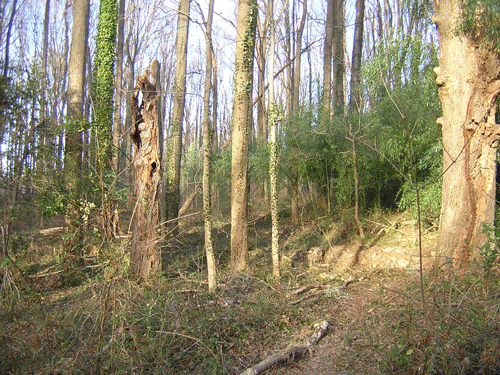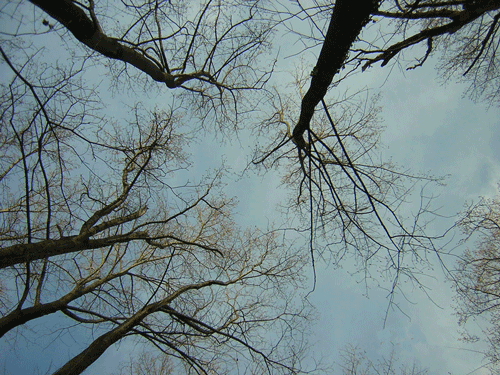
| Historic
Watershed Maps |
|
| Activities |
|
| you are here: home >areas of interest/concern > Burke's Spring > Burke's Spring (page 2) > Burke's Spring (page 3) > Burke's Spring (page 4) | |
The area around the spring is definitely worth preserving. There are some problems with invasive alien plants, especially the English Ivy seen in earlier pictures and on the trees in the picture below, and the bamboo visible to the right in this picture. However, there are also a variety of native trees and shrubs, including American Holly, Sassafras, Spicebush, and a number of Tulip Trees, the dominant tree species in the area. There are ferns on the forest floor, and this area, like other parts of the Haycock-Longfellow woods, undoubtedly also supports spring ephemerals (wildflowers that bloom in the spring, then disappear under the ground for the rest of the year) such as bloodroot, jack in the pulpit, and mayapple. More ephemerals would appear if the English Ivy were cleared from the forest floor. Even the snags (dead trees) you see in the picture have their use; besides having a beauty of their own, they provide shelter for birds and small mammals, and food for woodpeckers and other insect eaters. The picture below was taken looking northeast toward the spring from an existing social path that starts at the bottom of Crutchfield St., goes past the spring, and eventually ends up in Haycock/Longfellow Park. The springhouse foundations are visible to the left of the large tree at the right-hand side of the picture.
We hope that the preserved area around the spring will also be large enough to preserve a number of mature and nearly-mature trees that surround the spring, including the Tulip Trees silhouetted against the sky above the spring in this picture:
|
|
| Home | Watershed Map & Areas of Interest/Concern |
Historic Watershed Maps | Activities | Contact/Join Us |
All items copyright © 2003-2005
Friends of Burke's Spring Branch unless another source is noted.
Copyright for items with identified authorship remains with the
author(s); historical and other documents reproduced here are, to
the best knowledge of the webmaster, in the public domain. Items
under Friends of Burke's Spring Branch copyright may be reproduced
for nonprofit research or educational use as long as this copyright
notice is included. Please direct comments and questions to Cathy
Saunders. |

